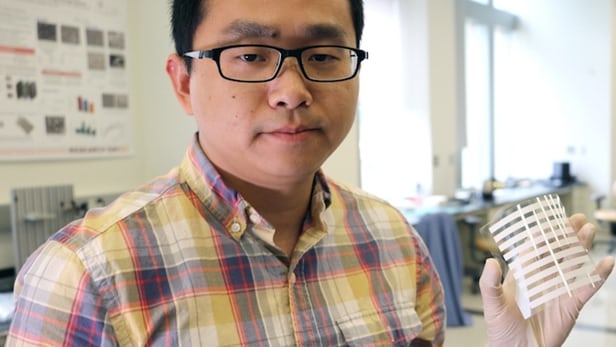When you think about solar panels on a house, you picture them on the roof. Considering the sun is outside in the sky, this makes sense. But solar panels can also be placed in windows or on walls, and can even be put to use while hiding indoors. A team of researchers at Virginia Tech is developing low-cost, flexible solar tiles that can be incorporated into curtains and wallpaper to capture both natural and artificial sunlight.

Researcher Congcong Wu holds up one of the flexible artificial light-recycling tiles. Image source: Virginia Tech.
Less than a millimeter thick, the new solar panels are palm-sized and can generate about 75 mW of power. Made using a screen-printing process that adheres a layer of titanium oxide paste into a thin, flexible base, they’re scaled up in rolls to be used in curtains, window shades, and wallpaper.
One major benefit is that the technology is fairly cheap to produce, and it’s manufactured at low temperatures, making the equipment to fabricate the panels easy to operate. Better yet, the scalability of being able to create the panels in sheet rolls means you could wallpaper your home in the panels to run everything from your alarm system to recharging your devices — you could even use it to power your LED lights.
The most useful feature is likely the panels’ ability to absorb diffused light. This means the range of light they can harvest extends beyond sunlight, and into that thrown off by LED, incandescent, and fluorescent lighting. Basically, the system could recycle the light from a building’s internal fixtures to help power those same lights.
Currently the panels operate at about 10% efficiency, which isn’t far off from the peak efficiency of 13 to 15% of amorphous silicon panels. The team believes the efficiency can be increased to the point where flexible panels outpace them, eventually making them viable to be woven into clothing, such as military uniforms and backpacks.
Right now the researchers are on the edge, actively working to integrate the product with the market while seeing a wide variety of uses for the technology from clothing to windows, to smart buildings to UAVs, to mobile charging stations.
The research was originally published in the journals Solar Energy Materials and Solar Cells and ACS Energy Letters .
Advertisement
Learn more about Electronic Products Magazine





